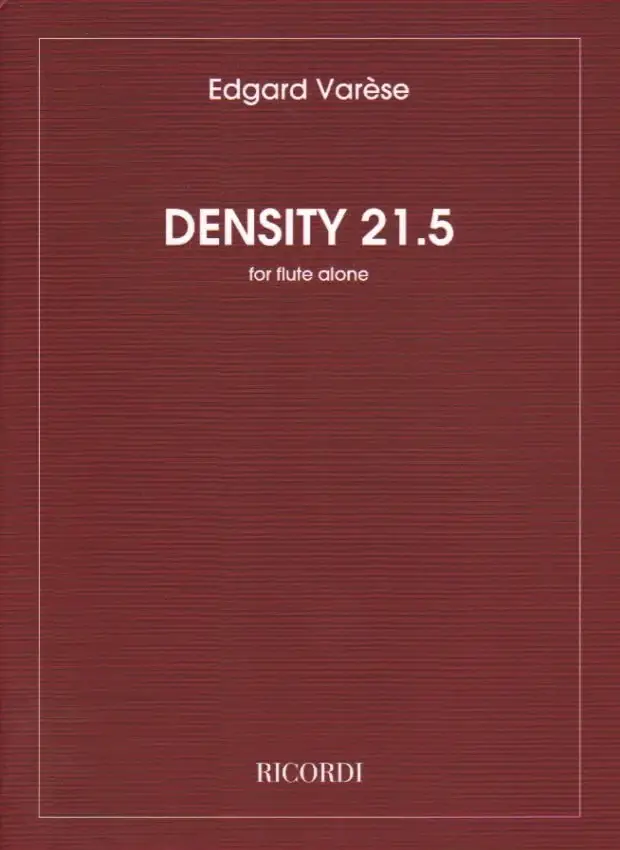
The Premiere of Edgard Varèse’s Density 21.5
Introduction to a Groundbreaking Work
Edgard Varèse’s Density 21.5, composed in 1936, is one of the most influential works in the 20th-century flute repertoire. Written for Georges Barrère, who had just acquired a platinum flute, the work takes its title from the density of platinum, 21.5 grams per cubic centimeter. Density 21.5 is renowned for its exploration of the flute’s sonic possibilities, and it revolutionized how composers approached the instrument in modern music.
Varèse, a pioneering figure in modernist music, was known for his interest in timbre and sound as fundamental compositional elements. In Density 21.5, he employed extended techniques and bold, dissonant sonorities to push the boundaries of traditional flute performance.
The Premiere
Density 21.5 was premiered on January 16, 1936, in New York City by Georges Barrère, for whom it was written. Barrère, one of the most prominent flutists of the time, had been gifted a platinum flute and sought a work to showcase this unique instrument. Varèse responded with Density 21.5, a piece that demands both technical mastery and interpretative depth.
The premiere was a pivotal moment in flute history. Varèse’s avant-garde approach, using unusual intervals, fragmented melodies, and sudden dynamic changes, left a lasting impact on audiences and composers alike. The work’s bold exploration of dissonance and the flute’s extended register demonstrated that the instrument could transcend its traditionally lyrical role, becoming a vehicle for modernist expression.
Structure and Musical Content
Density 21.5 is a brief work, typically lasting around four minutes, but it is dense with musical ideas and innovations. The piece opens with a bold, declarative gesture, a forceful attack on a single pitch that sets the tone for the entire work. From there, Varèse explores the extremes of the flute’s range, from the lowest notes to piercing high tones, challenging the flutist’s control over dynamics, articulation, and intonation.
The work is built on a series of angular, dissonant intervals, often exploiting the natural harmonics of the instrument. Varèse uses a variety of extended techniques, such as flutter-tonguing and sudden shifts in register, to create a soundscape that is both abstract and emotionally intense. The title’s reference to the physical density of platinum hints at the compactness and weight of the music itself, despite its brevity.
Density 21.5 has no clear tonality or melodic theme in the traditional sense, but instead, it presents a study in sound color and texture. The work’s episodic structure and its radical use of the flute’s timbral possibilities have made it a quintessential piece in the exploration of contemporary flute techniques.
Importance and Legacy
Density 21.5 is widely considered a revolutionary work, not just for the flute but for 20th-century music as a whole. It is often credited with introducing the flute to the modernist movement, demonstrating the instrument’s capacity for producing new and unexpected sounds. The piece became a model for later composers who sought to expand the sonic possibilities of the flute, including Luciano Berio and Pierre Boulez, both of whom were influenced by Varèse’s innovative use of timbre and structure.
The work’s importance also lies in its role as a bridge between Varèse’s earlier orchestral works and his later, more experimental electronic compositions. Density 21.5 distills many of the ideas that Varèse would later explore in larger-scale works, such as his interest in pure sound and the use of music as a spatial and physical phenomenon.
Today, Density 21.5 remains a staple of the flute repertoire, performed by flutists around the world both as a concert piece and a technical showcase. Its demands on the performer—requiring precision, control, and an understanding of the flute’s extended techniques—make it a challenging and rewarding work to master.
Conclusion
Edgard Varèse’s Density 21.5, premiered by Georges Barrère in 1936, is a landmark in the history of 20th-century flute music. Its bold, avant-garde approach redefined the flute’s role in modern music, opening up new possibilities for composers and performers alike. Despite its brevity, the work’s influence has been profound, cementing Varèse’s place as a pioneer of modernism and shaping the trajectory of contemporary flute music
This event has passed.
Premiere of Edgard Varèse’s Density 21.5

